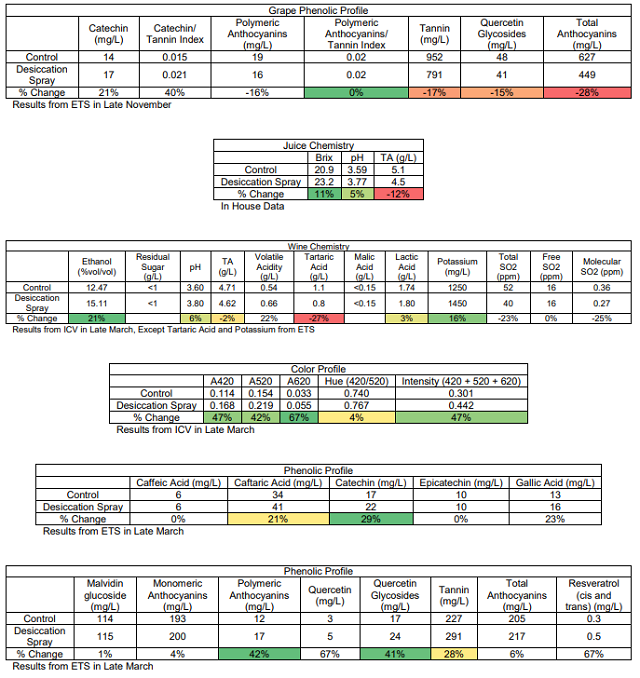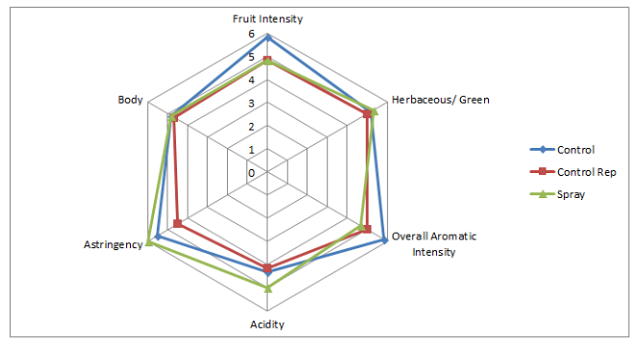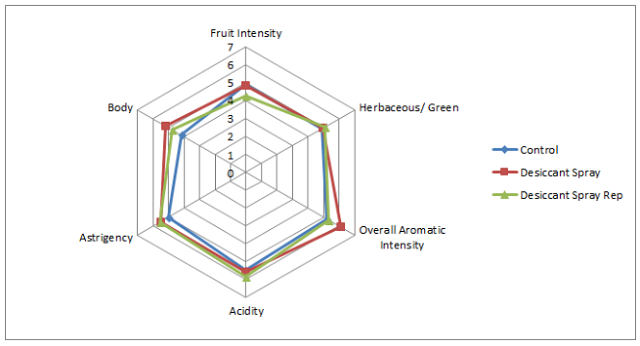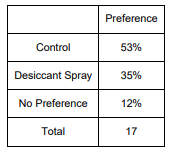Vineyard Desiccation Sprays to Improve Ripening in Cabernet Franc (in collaboration with Bruce Zoecklein) (2017)
Michael Heny and Andy Regan
Horton Vineyards
Summary
This study examines the impact of vineyard desiccant sprays on grape ripening and wine quality in Cabernet Franc. A block of Cabernet Franc was divided so that part of the block was backpack-sprayed with a desiccant spray (2% solution of methyl esters of fatty acids in 2% solution of potassium carbonate in water) provided by Bruce Zoecklein. The spray treatment occurred when the grapes had reached approximately 19 Brix (September 22, 2017) and clusters were coated until dripping with spray. Grapes were harvested on September 28 and were processed identically. Wines were pressed after 11 days of maceration. Cluster weight, total anthocyanins, and tannin were decreased in sprayed fruit. Brix was increased and acidity was decreased in sprayed fruit as well. Alcohol and potassium were higher in the sprayed wine, and acidity was lowered. Color, tannin, and polymeric anthocyanin were also higher in the sprayed wine, in spite of opposite trends being seen in this regard with the grapes. Overall, these wines were found to be significantly different. There was a tendency for the desiccated wine to have higher Body. Desiccated wines had a slight tendency for higher Acidity and Astringency, and lower Fruit Intensity. However, more sensory studies are needed to confirm these trends. There may have been a very slight preference for the non-desiccated wine. In the future, more studies should be performed on fruit desiccation, as it has potential to be a useful tool in Virginia grape growing. These studies should include the timing of desiccation sprays before harvest.
Introduction
In regions with common rainfall, ripening problems may occur due both to dilution from rain as well as from forced early harvest to avoid excessive disease pressure. As such, crop management techniques provide a key tool to enhance ripening kinetics and reduce disease pressure. One such method for crop management involves crop desiccation. Desiccation naturally concentrates several ripeness factors in grape berries, and often enhances grape respiration resulting in lower malic acid. Crop desiccation occurs naturally in regions with low rainfall but is generally impeded by rain. This study examines the impact of a desiccation spray on the chemical and sensory qualities of Cabernet Franc.
Results and Discussion
Cluster weight, total anthocyanins, and tannin were decreased in sprayed fruit. Brix was increased and acidity was decreased in sprayed fruit as well. Alcohol and potassium were higher in the sprayed wine, and acidity was lowered. Color, tannin, and polymeric anthocyanin were also higher in the sprayed wine, in spite of opposite trends being seen in this regard with the grapes.


For the triangle test on May 9, of 6 people who answered, 4 people chose the correct wine (67%), suggesting that these wines were not significantly different. These wines are significantly different at p<0.10. In general, people who answered correctly preferred both wines equally. For the descriptive analysis, there were no strong trends for the descriptors used in this study. The control wine may have had slightly higher Fruit Intensity and Overall Aromatic Intensity. The sprayed wine tended to have higher Astringency and Acidity. Judges tended to think these wines had a reductive character.

For the triangle test on May 30, of 27 people who answered, 17 people chose the correct wine (63%), suggesting a statistically significant difference between wines (p<0.01). These wines were voted to have an average degree difference of 5.35 (out of 10), suggesting that the wines were fairly different. In general, people who answered correctly had a slight preference for the control wine, but this preference was weak. For the descriptive analysis, there was a somewhat strong trend for Body to be higher in the desiccant spray (LSD=0.73) (the average of the desiccant replication scores was greater than the LSD from the control, although one of the desiccant replication scores was within the LSD). There was a slight trend for the desiccant spray to have lower Fruit Intensity, and higher Overall Aromatic Intensity, Acidity, and Astringency.


Overall, these wines were found to be significantly different. There was a tendency for the desiccated wine to have higher Body. Desiccated wines had a slight tendency for higher Acidity and Astringency, and lower Fruit Intensity. However, more sensory studies are needed to confirm these trends. There may have been a very slight preference for the non-desiccated wine. In the future, more studies should be performed on fruit desiccation, as it has potential to be a useful tool in Virginia grape growing. These studies should include the timing of desiccation sprays before harvest.
Methods
A block of Cabernet Franc was divided so that part of the block was sprayed with a desiccant spray (oil and potassium carbonate, 2% solution methyl esters of fatty acids in 2% solution of potassium carbonate in water) provided by Bruce Zoecklein with a backpack sprayer. The grapes were sprayed on September 22, 2017 when the sugar had reached around 19 Brix. Clusters were coated to dripping and left to hang until target harvest Brix is obtained. Brix sampling was done on September 21, and on September 25.
The grapes were harvested on September 28, 2017 and destemmed and crushed into 2 T bins. Each T bin received 30ppm sulfur dioxide and 60mL/ton Color Pro. Yeast strain was not specified. On October 2, each bin received 1g/hL MBR31 and 2g/L tartaric acid. On October 5, the sprayed wine received 1g/L tartaric acid. 1g/hL tartaric acid may have been added to the no spray control on October 7, but this is a postulation based on the data and other methodological trends. The wines were pressed on October 9, and so had an 11 day maceration. The sprayed wine seemed to have more color and fruit aroma at this point.
These wines were tasted on May 9 and May 30. For the triangle test, descriptive analysis, and preference analysis for the May 9 tasting, anybody who did not answer the form were removed from consideration for both triangle, degree of difference, and preference. Additionally, anybody who answered the triangle test incorrectly were removed from consideration for degree of difference and preference. Additionally, any data points for preference which did not make sense (such as a person ranking a wine and its replicate at most and least preferred, when they correctly guessed the odd wine) were removed.
In order to balance the data set to perform statistical analysis for descriptive analysis on the May 9 tasting, any judge who had not fully completed the descriptive analysis ratings were removed. In order to then make the number of judges between groups equivalent, one judge from group 1 was eliminated. This resulted in a final data set of 3 groups, each with 2 judges (considered as replications within groups, and groups were considered as assessors). Data was analyzed using Panel Check V1.4.2. Because this is not a truly statistical set-up, any results which are found to be statistically significant (p<0.05) will be denoted as a “strong trend” or a “strong tendency,” as opposed to general trends or tendencies. The statistical significance here will ignore any other significant effects or interactions which may confound the results (such as a statistically significant interaction of Judge x Wine confounding a significant result from Wine alone). The descriptors used in this study were Fruit Intensity,Herbaceous/Green, Overall Aromatic Intensity, Acidity, Astringency, and Body.
The same procedures for data analysis were used on the May 30 tasting. For the descriptive analysis in this tasting, one judge was transferred from group 3 to group 1, and one judge was eliminated from group 3 so that each group had 8 judges, for a total of 24 judges.
